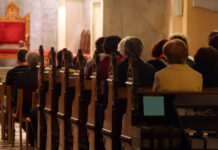What started this for me was a fascination with the fourth of Jesus’ seven parables found in Matthew 13. As I often do when faced with a long drive from a meeting back home, I picked a scripture that intrigued me in order to consider it from every angle.
This may be the most neglected parable from all those taught by Jesus, methinks.
The kingdom of heaven is like leaven, which a woman took and hid in three measures of meal till it was all leavened. (Matthew 13:33)
I had been working on a message on how Christians hide themselves inside their church buildings when the Lord wants us permeating the community with the gospel. This parable seemed a natural.
I had been interpreting it with an emphasis on “a woman took and hid” the leaven in the dough. She had some leaven and wondered where to hide it. “I know,” she thought. “I’ll hide it in this dough.” But a few hours later or the next morning, the world knew where she had stashed it. The power of the leaven to affect everything around it changed the dough and thus gave the presence of the leaven away.
That speaks to Christians wanting to remain secret disciples of Jesus. Dietrich Bonhoeffer said: Secret discipleship is a contradiction in terms. Either the secrecy will kill the discipleship or the discipleship will kill the secrecy.
Then, I called a friend on the phone. Mike knows his Greek. I wanted to know what the Greek New Testament could contribute to my understanding of that fourth parable.
“The word in the Greek is ‘hid,’ all right,” said Pastor Mike. “But the commentary I checked said we should not make too much of the fact that she hid the leaven. She just put it inside the dough. The emphasis is not on her hiding it but on the way the leaven influences everything it touches.”
Well, all right, I thought, reluctantly. I had thought I was on to something with the emphasis on the “hid” word.
Then, next morning, with my office next door to the church library, I started pulling out commentaries.
Not a good thing.
Any preacher who opens commentary after commentary expecting to settle an issue on what does the Bible say here, what did it mean then, and what does it mean now, is going to be disappointed.
G. Campbell Morgan, prince of Bible expositors.
In his commentary on Matthew, Morgan says, “There are two interpretations of this parable.” Some people treat the leaven as “a type of the kingdom.” They emphasize that Jesus said, “The kingdom of heaven is like unto leaven.” However, Morgan says, other people see that as missing the Lord’s meaning. These say you must take all the parable into account to get the meaning.
That sounds all right, but then he does something interesting.
He writes, “If the first interpretation of the parable…be the correct one, we are necessarily driven to the conclusion that in this instance leaven must be the type of good, and that as a result of its working all things will be finally brought into subjection to the King.”
The second view, he says–and he admits to holding it–is that in the Bible leaven is always a type of evil. So, Morgan rejects the first interpretation because it is “out of harmony with the symbolic use of leaven in the Bible.”
Is that true? Not so fast. Check out Leviticus 23:17. (For the feast of weeks) You shall bring from your dwellings two wave loaves or two-tenths of an ephah. They shall be of fine flour; they shall be baked with leaven. They are the firstfruits to the Lord.
Granted, the Bible in most cases does make leaven a symbol of sin. But not always. And to make Matthew 13:33 refer to the permeating power of sin is to miss something vital in the Lord’s teaching, it seems to me.
Furthermore, I find it amazing that G. Campbell Morgan, whose commentaries on Scripture have enriched me for over half a century of preaching, would infer that to take the obvious meaning of that fourth parable is to imply that the entire world will be saved, well, that is just amazing. An incredible stretch, if you ask me.
Herschel H. Hobbs, the pre-eminent Baptist commentator during his lifetime.
In his commentary on Matthew, Hobbs knows the Leviticus 23:17 verse and correctly says “leaven does not always refer to evil.” Then he says, “We should not force into the meaning of one passage the symbolic meaning of another.” For instance, “lion” may refer to the devil (I Peter 5:8) but also to Jesus (Revelation 5:5).
To say that the meaning of a word in one text automatically requires it to mean the same thing in another is what (Hobbs says) A. T. Robertson calls “exegetical jugglery.” I like that.
So, Hobbs says, “We conclude that Jesus is simply saying that the kingdom of heaven is placed in the world as a piece of leaven is placed in the dough. From a very small beginning it will permeate the whole.
And if one grants that the parable envisions the whole world being affected by the leaven of the Kingdom, Hobbs notes, “This…points to that time when the sovereignties of this world shall become the sovereignty of ‘our Lord, and of His Christ’ (cf. Rev. 11:15).”
Good, as far as it goes. I note, however, that Dr. Hobbs said nothing about the woman “hiding” the leaven inside the dough.
Frank Stagg, in the Broadman Commentary.
He writes, “In the Old Testament and elsewhere in the New Testament, leaven is a symbol for evil (cf. 16:P6, 11, f.), but that seems impossible here. In this parable leaven conquers the whole lump of dough, and Jesus did not teach the triumph of evil. It is the kingdom of heaven, not evil, which works like leaven.”
Good. That’s all he says.
Thru The Bible’s J. Vernon McGee.
I like Dr. McGee because he doesn’t mince words. You might not agree with him, but you are never left wondering what he really thinks.
Interestingly, in his commentary on this scripture, McGee begins, “The parable of the leaven is the key parable of this chapter.” He goes on to say, “The Gospel of Matthew is the key book of the Bible. Chapter 13 is the key chapter of Matthew. And verse 33 is the key verse of chapter 13. So, actually, what we have here is one of the key verses of the Bible!”
He says, “There are those who interpret the leaven as the gospel, and they ought to know better! Nowhere is leaven used as a principle of good; it is always a principle of evil.” “It is always used in a bad sense,” he says.
We have already pointed out that Leviticus 23:17 contradicts that.
So, what does Dr. McGee do with this parable? He does some exegetical juggling.
“The gospel is represented by the three measures of meal. How do we know this? Because meal is made out of grain or seed, and our Lord has already told us in the parable of the sower that the seed represents the Word of God.”
To my amazement, he goes on to point out that women in the Bible (“in a doctrinal sense”) are always used as a principle of evil. (Dr. McGee reminds me of what one fellow said of his pastor: He’s not always right but he’s never in doubt.”)
Well, at least, I notice that Dr. McGee has the woman HIDING the leaven. He says, “She takes the leaven and hides it in the meal. If the leaven represents the gospel, why in the world did she hide it? The gospel is to be shouted from the housetops and heralded to the very ends of the earth. Obviously, the leaven is a principle of evil….”
He writes, “This parable teaches that the intrusion of wrong doctrine into the church will finally lead to total apostasy.”
Here we have Dr. McGee saying the Lord is teaching the triumph of evil.
Sorry. This is where I disembark from his “gospel bus.”
Matthew Henry’s Commentary.
Henry writes, “The apostles, by their teaching, hid a handful of leaven in the great mass of mankind, and it had a strange effect; it put the world into a ferment, and in a sense turned it upside down (Acts 17:6).”
He says, “Hide but the leaven in the dough, and all the world cannot hinder it from communicating its taste and relish to it, and yet none sees how it is done, but by degrees the whole is leavened.”
Ronald S. Wallace in “Many Things in Parables.”
He writes, “When leaven is introduced into dough there may at first be little effect, but soon there is upheaval and disturbance, a violent fermentation spreading through the whole mass of the dough. The influence of the leaven penetrates every particle and nothing is left unchanged. Nothing can prevent the leaven, once introduced, from modifying every part of the whole mass. That is Jesus’ prophecy of how His Gospel will act on human society. It will produce disturbance, reaction and conflict wherever it is sown, right through the whole range of human life.”
He answers the critics who would read his view as saying that eventually the world will be saved by the gospel. “Leavened society is not the Kingdom of God. There is an idea in the minds of many people that as time passes, and more and more the influence of the Gospel is felt on the social life of man, society may become better and better till it actually is found to have become a real Kingdom of God on earth….” But not so.
John MacArthur in the MacArthur Study Bible.
He writes, “Here the kingdom is pictured as yeast, multiplying quietly and permeating all that it contacts. The lesson is the same as the parable of the mustard seed. Some interpreters suggest that since leaven is nearly always a symbol of evil in Scripture…it must carry that connotation here as well. They make the leaven some evil influence inside the kingdom. But that twists Jesus’ actual words and violates the context, in which Jesus is repeatedly describing that kingdom itself as the pervading influence.”
Thank you, Dr. MacArthur. Very helpful.
Robert Farrar Capon, Episcopal priest and seminary professor.
In his The Parables of the Kingdom, Capon writes, “I shall not even try to restrain my natural enthusiasm for this parable. Not only does its reference to yeast delight my deepest roots (I have for decades made my own bread, without even once losing my fascination with the process).”
Capon says we are to notice that “the whole is leavened,” and “he’s not kidding. The lump stands for the whole world.”
“The hiding of yeast in a batch of dough is both more mysterious and more pervasive than any of the hidings Jesus has so far used to illustrate the kingdom. Seeds may disappear into the ground, but if you are willing to take the trouble to hunt and peck for them, you can conceivably get every last one of them back up and out of the field…. But yeast? No way…. Just as yeast enters into the dough by being dissolved in the very liquid that makes the dough become the dough at all…so this parable insists that the kingdom enters the world at its creation and that there is not, and never has been, any unkingdomed humanity anywhere in the world.”
Say what? Careful there, friend. Methinks you overstep this little one-sentence parable. If I read Capon correctly, he is making this little parable into an allegory–even the pockets of carbon dioxide have a meaning–and concluding things far outside the bounds of conservative (and careful) biblical interpretation.
Okay. Enough of this. I’ve ransacked all the commentaries in my office and some in the church library. Granted, I gave away several sets of commentaries when I retired from the pastorate, so my personal library is sorely lacking these days. But what are we to make of all this?
Here are my conclusions on the matter, not of interpreting this tiny parable, but of consulting experts for their point of view.
1) Anyone can be an expert. Just write a book.
I mean that facetiously, but it seems to be the case in 21st century America. Church people, to their everlasting shame, seem to be taken by preachers with doctor’s degrees. These days, Ph.D.s and D.Min.s seem to drop from trees. My own opinion is the gaudier the minister wears the degree, the less he did to earn it and the less academic worth it arries.
2) To yield to an authority just because he wrote a book is foolish.
I’ve written books. It’s not that big a deal.
Read the authorities. Listen to what they are saying. You might learn something. But don’t automatically take it as gospel just because a highly acclaimed somebody said it.
3) The experts hardly agree on anything.
That should not surprise us. That’s why we have scores of denominations and theological seminaries in every major city in the world.
4) We do not dismiss a point of view just because we distrust experts.
Listen to the point the writer makes. Even the worst heretic may have a slant you never thought of.
5) Even if you disagree with a position, it’s good to be familiar with it.
If nothing else, when someone challenges you about what you preached, you are prepared.
6) Eventually, you may come to two important conclusions:
–All experts and authorities are human with limitations.
–You are a human with limitations, so it could be that your point of view is the correct one.
7) If your view squares with the Bible and the gospel message, even though no expert backs it up, preach it. (Caution: This is a huge reason I suggest every pastor have a couple of veteran ministers with whom he can run things by, to get their “take.” These mentor/friends may not be “experts” in the sense we’re using it here, but you respect them and value their input.
Dr. Adrian Rogers stood in my office study one day pulling out books and checking to see what I had. At one point we got into a conversation over–and I hesitate to identify the subject of our disagreement lest we get off the point here–whether Cain’s offering was rejected because it was vegetable/plant and not animal/blood. He held that the absence of blood made it unacceptable, while I responded that nothing in the Word indicates that, that no such command had been issued to the Adam/Eve family.
After a bit, Dr. Rogers said, “Well, either way, we’re both preaching the truth of the gospel.” And I agreed.
It’s not necessary to agree on every detail.
It is not necessary to yield to the experts on anything.
A healthy skepticism is a good trait to bring to reading any commentary, at least until the writer has earned your trust.
Each Bible student, teacher, and preacher, should be so familiar with the Word that he/she can arrive at their own conclusions on issues where good people differ.







